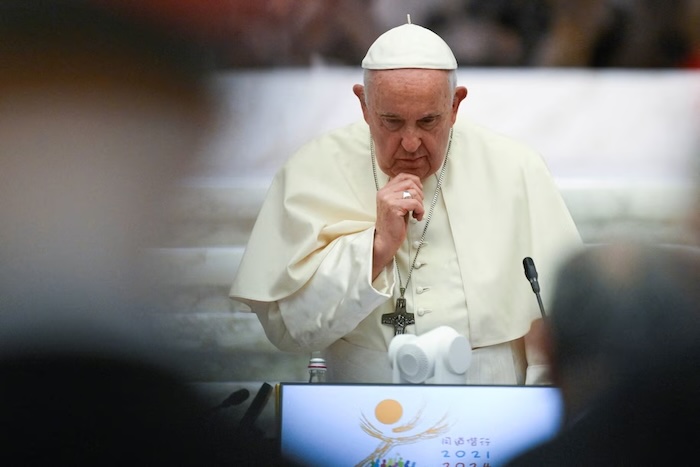
The assembly that Pope Francis opened in Rome last week is radical, though not in the sense that his right-wing critics have in mind. Its purpose is downright revolutionary for our era: He’s trying to get the Catholic Church’s warring camps to listen to each other.
The meeting’s mysterious name — “Synod on Synodality” — calls to mind the old joke about “the Department of Redundancy Department.” Synodality is a very churchy word that spell check has problems with and that even devout Catholics rarely summon.
But synodality, defined as consulting, listening and deliberating together (Francis is fond of the word “encounter”) is precisely the point of the meeting. It involves not only cardinals and bishops but also priests and lay people, including women — a big step for a church that privileges male power.
The synod has its roots in the Second Vatican Council of the 1960s that opened the church to the world, commended the synodal approach and defined the church not in terms of some ecclesiastical structure but as “the people of God.”
These days, the Catholic “people of God” are fiercely divided, not unlike many other faith traditions and entire nations. This frustrates Francis who thinks “the joy of the Gospel” should be enough for all factions. He hopes that reasoning together might remind them of this.
“I think he wants to create the conditions for the church to have a future,” said a Catholic official involved in planning the synod who preferred not to be named, “and if it’s to have a future, it has to learn to get along with itself, and outsiders, too.”
The preparatory document for the synod spoke of an imperative “to manage tensions without being crushed by them” (an idea that might be appealing right now in the U.S. Congress). “If it’s successful,” the official added of the synod, “it could change the ways in which Catholics sort out their own differences and that could be a gift to the wider culture.”
Such happy endings are rare in this imperfect world, and the church is still dealing with fallout from the sex abuse scandals, large-scale defections among the young, and differing priorities in the Global North and South. Francis’s open-ended vision is itself a challenge to traditionalists who think the church’s doctrine is immutable and its job is to hold fast and keep proclaiming it.
Many progressive Catholics — with whom I identify — hope a three-year process that began with consultations among Catholics around the world could culminate in Vatican III and a new round of major reforms. Among them: opening the priesthood to women and married men, a change in the church’s doctrinal approach to LGBTQ+ and divorced people, and a greater emphasis on social justice and environmental concerns.
But the dreams of liberals are the nightmares of church conservatives, as Francis’s critics brought home with a statement on the eve of the synod in which five cardinals explained a series of skeptical questions they had posed to the pope this summer. The traditionalists claimed that statements from “highly placed prelates” were “openly contrary to the constant doctrine and discipline of the Church” and could “generate great confusion and the falling into error among the faithful.”
Popes don’t always respond to such questions (known as “dubia”), but Francis did. He offered a classic summary of the view that there’s nothing wrong with a tradition keeping itself alive by responding to new insights and circumstances. “The Church,” he wrote, “must be humble and recognize that she never exhausts its unfathomable richness and needs to grow in her understanding.” He added: “Every theological current has its risks, but also its opportunities.”
In the short term, the synod is unlikely to meet liberal hopes or justify conservative fears. But this will not reassure Francis’s critics because his definition of the church’s central task differs from the prescriptions of his predecessors, Popes Benedict XVI and John Paul II.
“Pope Francis is attempting to move us away from the culture war mind-set,” said Cathy Kaveny, a professor of law and theology at Boston College. “John Paul and Benedict were responding to the problem of relativism. Pope Francis recognizes that the real problem is nihilism, the view that nothing and no one has value. What overcomes nihilism is not an argument but personal encounter that reveals the value of people and the communities they build together.”
The pope’s approach to LGBTQ+ issues fits this model. “He’s made a critique of theology that isn’t sufficiently rooted in pastoral concerns,” said the Rev. David Hollenbach, a moral theologian at Georgetown University (where I teach), meaning thinking about how people are treated. As Francis wrote in his reply to the conservative Cardinals, “we cannot be judges who only deny, reject, and exclude.”
The synod will meet until the end of the month, and there will be another session next year. A lot could happen, or people might just keep talking. In his sermon opening the synod, Francis urged participants to be “open to the surprises of the Holy Spirit.” Given the stresses the pope is trying to ease, the Holy Spirit has a lot of work to do.
Complete Article ↪HERE↩!
